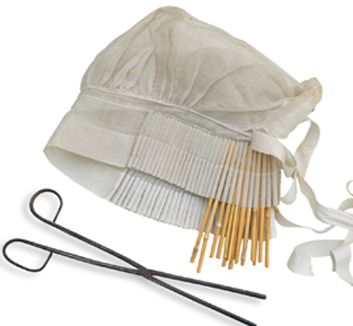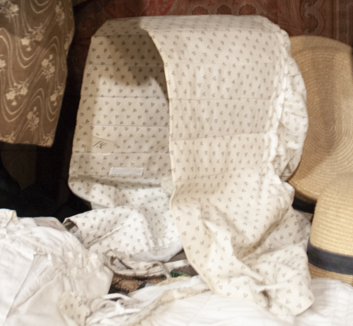HEADGEARS & COSTUMES
-
 In the 19th century, women never showed their hair in public. For everyday life, they wore flat bonnets: white, starched headdresses, made of muslin or fine fanciful cotton. Children also had their bonnets, as finely decorated as their mothers'.
In the 19th century, women never showed their hair in public. For everyday life, they wore flat bonnets: white, starched headdresses, made of muslin or fine fanciful cotton. Children also had their bonnets, as finely decorated as their mothers'.
Around 1900, there was a ruched bonnet trend (see picture): a more practical option. For a mourning, a black ribbon would be placed between the ruching.
In each canton, a detail made the headdress different. Between 1900 and 1930, these headdresses gradually disappeared. -
 The cayon is the headdress reserved for important, solemn days. It is decorated with handmade embroidery, rich lace tufted with iron or straw, or pleated with fingernails (a very long fingernail would be grown and used for pleating). The hairstyle could be completed with a fine crown of worked ribbon or fleurets or ostrich feathers. Finally, a ribbon bow made of faille (a coarse-grained silk fabric) was attached at the back with pins. In place of the ribbon, a wreath of orange blossoms would be used for weddings.
The cayon is the headdress reserved for important, solemn days. It is decorated with handmade embroidery, rich lace tufted with iron or straw, or pleated with fingernails (a very long fingernail would be grown and used for pleating). The hairstyle could be completed with a fine crown of worked ribbon or fleurets or ostrich feathers. Finally, a ribbon bow made of faille (a coarse-grained silk fabric) was attached at the back with pins. In place of the ribbon, a wreath of orange blossoms would be used for weddings.
-
 In the centre of the wardrobe is a bridal crown, a treasured keepsake. On either side are several cayons and bonnets. On the rod hangs the collets (collars), capes of different lengths, the everyday black wool caracos and the Sunday ones adorned with beads. At the bottom of the door is a quichenotte — used to protect the neck from the sun and to shade the face - and a sun umbrella. The inside of the door is covered with several shawls, one in blue wool with rose decoration, another in red, brown and beige silk, also adorned with roses.
In the centre of the wardrobe is a bridal crown, a treasured keepsake. On either side are several cayons and bonnets. On the rod hangs the collets (collars), capes of different lengths, the everyday black wool caracos and the Sunday ones adorned with beads. At the bottom of the door is a quichenotte — used to protect the neck from the sun and to shade the face - and a sun umbrella. The inside of the door is covered with several shawls, one in blue wool with rose decoration, another in red, brown and beige silk, also adorned with roses.